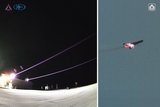Rafael enhances Drone Dome with CRFS's RFeye technology
The CRFS RFeye sensor has been integrated with Rafael's Drone Dome. (Photo: Rafael)
CRFS’s RFeye RF technology has been successfully integrated as sensor option into Rafael’s Drone Dome, a C-UAS system in service with the UK MoD and ordered for an undisclosed Asian customer.
It was reported that Drone Dome was used in 2021 to protect world leaders during the G7 Summit in Cornwall, England from uncrewed aerial threats.
Rafael reports that on behalf of a European-based NATO partner it approached CRFS to enhance Drone Dome's RF detection and geolocation capability by integrating RFeye technology. CRFS has headquarters in Cambridge, UK and in the US.
Related Articles
Paris Air Show: Rafael showcase Drone Dome laser capability
UK selects Rafael’s Drone Dome
Rafael’s Drone Dome intercepts targets with new laser technology
The RFeye receiver is designed to offer RF performance in a rugged and simple deployment, with detection, geolocation and data filtering/streaming services through an open application programming interface.
In August 2018, after a demonstration in February of the same year, the UK MoD awarded an urgent capability requirement contract for a C-UAS capability to Rafael in a deal worth £7.6 million ($9.97 million).
Drone Dome is made up of three main components: RADA's RPS-42 radar subsystem, Controp's MEOS observation subsystem and Netline's C-Guard RD & NetSense subsystem.
The radar's detection range of 16km also works against a minimum target size of 0.002m² at 3.2km. Up to four radars can be arranged to ensure full 360º azimuth and 90º elevation coverage. The operator can detect targets as soon as the remote control is turned on.
When a threat enters the neutralisation area, a mobile directional jammer blocks all VHF, UHF, ISM, GPS and Wi-Fi links across the 20-6,000MHz frequency ranges. As the jammer covers about 70º, it avoids interfering with UAVs operating in permitted areas.
Related Equipment in Defence Insight
More from Digital Battlespace
-
![Babcock nears first customer for Nomad AI translation tool]()
Babcock nears first customer for Nomad AI translation tool
Nomad can provide militaries with real-time intelligence, saving critical time on the battlefield.
-
![AUSA 2025: Israel’s Asio Technologies to supply hundreds of improved Taurus tactical systems]()
AUSA 2025: Israel’s Asio Technologies to supply hundreds of improved Taurus tactical systems
Taurus operates alongside the Israel Defense Forces’ Orion system which supports mission management across tens of thousands of manoeuvring forces, from squad leaders to battalion commanders.
-
![AUSA 2025: Kopin pushes micro-LED plans as China moves faster]()
AUSA 2025: Kopin pushes micro-LED plans as China moves faster
The plan for the new displays follows fresh investment in Kopin’s European facilities by Theon and an order for head-up displays in fielded aircraft, with funding from the US Department of Defense.
-
![AUSA 2025: Persistent Systems to complete its largest order by year’s end]()
AUSA 2025: Persistent Systems to complete its largest order by year’s end
Persistent Systems received its largest ever single order for its MPU5 devices and other systems earlier this month and has already delivered the 50 units to the US Army’s 4th Infantry Division.
-
![Aselsan brings in dozens of companies and systems under the Steel Dome umbrella]()
Aselsan brings in dozens of companies and systems under the Steel Dome umbrella
Turkey has joined the family of countries attempting to establish a multilayered air defence system with government approval in August 2024 for the effort landed by Aselsan. Dubbed Steel Dome, the programme joins Israel’s Iron Dome, the US Golden Dome, India’s Mission Sudarshan Chakra and South Korea’s low-altitude missile defence system.
-
![DSEI 2025: MARSS unveils new agnostic multidomain C4 system]()
DSEI 2025: MARSS unveils new agnostic multidomain C4 system
MARSS’ NiDAR system has been deployed using sensors from static platforms to provide detection and protection for static sights, such as critical infrastructure, ports and military bases.


























